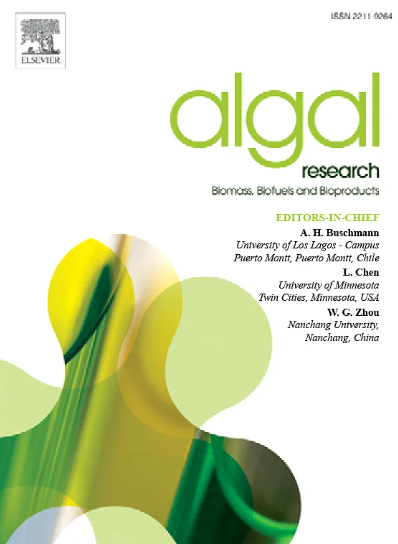了解UV-B反应和一氧化氮在蓝细菌聚球菌PCC 7335的变色适应性中的作用
IF 4.6
2区 生物学
Q1 BIOTECHNOLOGY & APPLIED MICROBIOLOGY
Algal Research-Biomass Biofuels and Bioproducts
Pub Date : 2025-04-27
DOI:10.1016/j.algal.2025.104059
引用次数: 0
摘要
太阳紫外线b (UV-B)辐射在生物体中根据照射剂量和照射时间的不同产生不同的反应。那些自养生活方式的人不断暴露在阳光下,并进化出缓解策略。一氧化氮(NO)是一种气体信号分子,与植物和蓝藻对UV-B的保护有关。聚球菌PCC 7335是一种特殊的蓝藻与适应不同的光制度和编码非规范的一氧化氮合酶(NOS)。在这项研究中,我们分析了UV-B的影响和NO在这种反应中的作用。我们的研究结果表明,UV-B处理减缓了生长恢复,尽管培养仍然可行。此外,辐照后NO水平增加的机制独立于NOS和硝酸还原酶(NR),表明可能通过非酶途径增加。此外,UV-B降低了藻胆蛋白(PBP)含量,但对叶绿素a水平没有影响。添加精氨酸作为NOS底物,对UV-B引发的色素降解无保护作用。在分子水平上,UV-B诱导ObgE同源基因和光解酶操纵子的表达,使培养物能够抵抗辐射。不受管制的NO生产不参与这些基因表达的调节。此外,UV-B和外源NO均可阻止S. PCC 7335生物膜的形成。本报告给出了新的见解蓝藻对UV-B辐射的反应,这与其他蓝藻描述的不同。本文章由计算机程序翻译,如有差异,请以英文原文为准。

Understanding the UV-B response and the role of nitric oxide in the chromatically adapting cyanobacterium Synechococcus PCC 7335
Solar ultraviolet-B (UV-B) radiation exerts different responses in organisms based on the exposure dose and duration. Those with autotrophic lifestyles are continuously exposed to sunlight and evolved mitigation strategies. Nitric oxide (NO) is a gaseous signaling molecule associated with the protection towards UV-B in plants and cyanobacteria. Synechococcus PCC 7335 is a peculiar cyanobacterium with adaptations to different light regimes and encodes for a non-canonical nitric oxide synthase (NOS). In this study, we analyzed the effects of UV-B and the role of NO during this response. Our findings demonstrate that UV-B treatment slows growth recovery although the culture remains viable. Also, NO levels increase post-irradiation through a mechanism independent of NOS and nitrate reductase (NR), suggesting a probable increase via a non-enzymatic pathway. In addition, UV-B reduces phycobiliprotein (PBP) content, but has no effect on chlorophyll a level. Arginine addition, which is the NOS substrate, has no protective effect towards pigment degradation triggered by UV-B. At the molecular level, UV-B induces the expression of the ObgE homolog gene along with a photolyase operon enabling the culture to counteract the radiation. The deregulated NO production is not involved in the regulation of the expression of these genes. In addition, both UV-B and exogenous NO prevent S. PCC 7335 biofilm formation. This report gives new insight into the response of cyanobacteria to UV-B radiation, which differs from those described for other cyanobacteria.
求助全文
通过发布文献求助,成功后即可免费获取论文全文。
去求助
来源期刊

Algal Research-Biomass Biofuels and Bioproducts
BIOTECHNOLOGY & APPLIED MICROBIOLOGY-
CiteScore
9.40
自引率
7.80%
发文量
332
期刊介绍:
Algal Research is an international phycology journal covering all areas of emerging technologies in algae biology, biomass production, cultivation, harvesting, extraction, bioproducts, biorefinery, engineering, and econometrics. Algae is defined to include cyanobacteria, microalgae, and protists and symbionts of interest in biotechnology. The journal publishes original research and reviews for the following scope: algal biology, including but not exclusive to: phylogeny, biodiversity, molecular traits, metabolic regulation, and genetic engineering, algal cultivation, e.g. phototrophic systems, heterotrophic systems, and mixotrophic systems, algal harvesting and extraction systems, biotechnology to convert algal biomass and components into biofuels and bioproducts, e.g., nutraceuticals, pharmaceuticals, animal feed, plastics, etc. algal products and their economic assessment
 求助内容:
求助内容: 应助结果提醒方式:
应助结果提醒方式:


